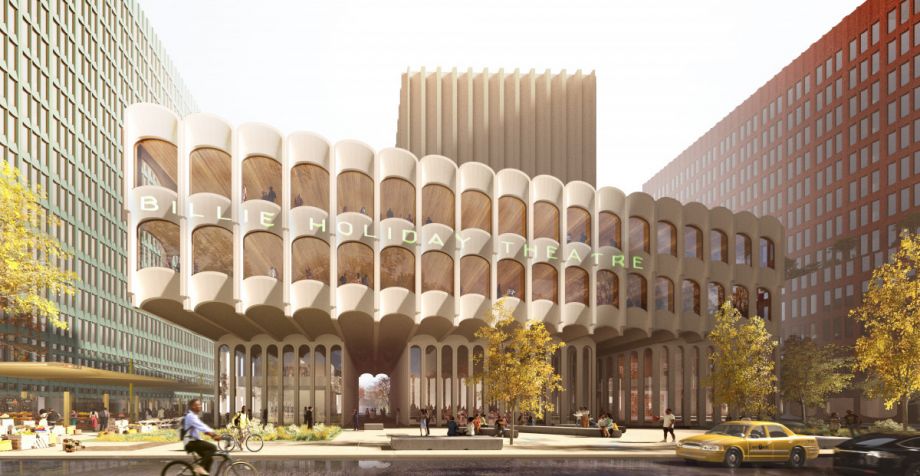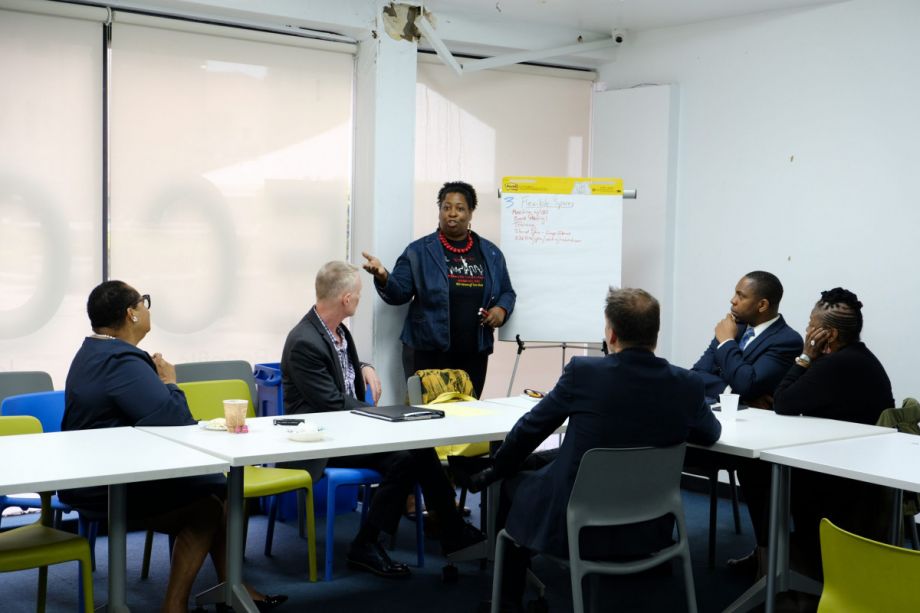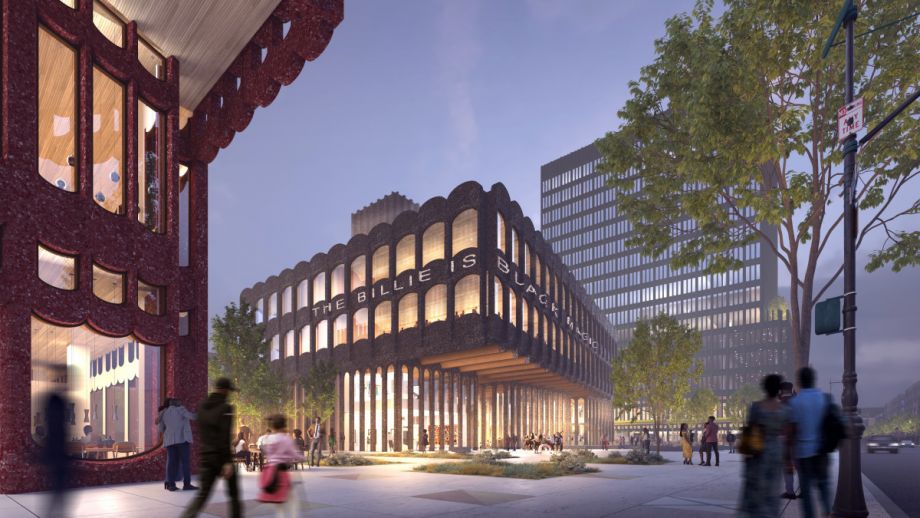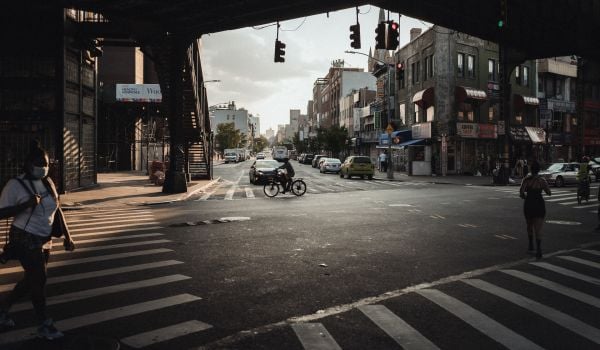In Brooklyn, one of the country’s first community development corporations has announced its plans to transform its historic and much-beloved public plaza into a walkable “innovation campus” that supports wealth creation for local Black residents, amid rising gentrification in the neighborhood.
The Bedford Stuyvesant Restoration Corporation was established in the Brooklyn neighborhood in 1967. One year later, Restoration purchased an abandoned milk bottling plant in Bed-Stuy’s heart to serve as its new headquarters.
Completed in 1972, Restoration Plaza became a community and business hub responding to the needs of residents. A desire for local arts and culture resulted in the Billie Holiday Theatre and Skylight Gallery. Need for office and community space translated to thousands of square feet for nonprofits, a post office, banks and the local community board. A grocery store owned by Restoration opened when the neighborhood was still a food desert; an Applebees opened when there were few sit-down places to dine.
“To a lot of long-ime residents, the plaza means a lot,” explains Colvin Grannum, the longtime former president of Restoration. “It represents hope.”
Still, the campus became outdated and Restoration sought to upgrade it. This February, after a strategic partnership and community visioning sessions, organizers unveiled plans for the Restoration Innovation Campus, an 840,000-square-foot hub with a public plaza, cultural space and offices to offer wealth-building opportunities for longtime residents.
“With Innovation Campus, we’re shining a spotlight on the rising racial wealth gap, and offering a replicable, self-funding model for Black communities across the country to close the gap and build wealth locally,” Grannum says.
Since its inception, the Bedford Stuyvesant Restoration Corporation has played a number of roles in the community: It provides a healthcare facility, social services, job and education programs. Restoration has helped over 20,000 residents find employment and rehabilitated and constructed 2,200 housing units. They helped found the Bed-Stuy Business Improvement District and purchased historic homes in Weeksville, one of America’s first free Black communities, before the site became the Weeksville Heritage Center.
Much of that work is centered at Restoration Plaza, which was designed as the neighborhood grappled with the impacts of redlining, white flight and overall disinvestment by the city. Cities around the country experienced unrest in response to these inequalities as well as police violence. “It was designed to be like an island to itself — you stepped into the plaza and out of Bedford Stuyvesant, into a different world,” says Grannum.

Rendering of plans for the Restoration Innovation Campus (Image courtesy of Adyaye Associates)
Residents and organizations like Restoration invested heavily in Bed-Stuy, and as the decades passed, the plaza began to feel separated from the new businesses (many of them Black-owned), community services, and restored apartment buildings and brownstones. “For a very long time, we knew that we needed a new campus, we just didn’t know if it would be feasible to do,” Grannum says.
Restoration also confronted a troubling reality. Despite its decades of work, the racial wealth gap persisted in the neighborhood, New York and across the country. An influx of white residents were gentrifying Bed-Stuy, but rising home values didn’t benefit many longtime residents — thousands of Black residents were actually leaving.
“We started looking at what’s next, and it disturbed me and the Restoration board that we had done all this great work but there was still a growing racial wealth gap,” says Grannum. “We wanted to dig deeper … and focus on helping residents build net worth.”
Restoration faced its own challenges: “We’re asset-rich but cash-poor,” as Grannum puts it. “The plaza is the most valuable asset we have, besides our people, so we started to think how we could take this unique asset and leverage it, so we could do the work we wanted to do around the racial wealth gap at scale.”
In 2018, Restoration began working with a longtime supporter, financier Alan Fishman, to kick off planning around the plaza. “He’s bringing liquidy and an all-star cast of professionals” including well-known architect David Adjaye, says Grannum. “That’s the kind of capital we did not have.”
In 2019, Restoration began hosting “visioning sessions” in partnership with the local community board, which is headquartered at the plaza, and architecture firm Adjaye Associates. “Residents definitely wanted to maintain this as a community space, especially the culture and the arts,” says Henry Butler, district manager of the community board. “They also wanted to maintain this as a resource with workforce development, but with 21st century workforce development.”

A “visioning session” with community members. (Photo courtesy Restoration Plaza)
Adjaye designed a plaza considering the top four priorities that emerged: increasing the visibility of the arts programs, expanding job and educational opportunities, improving the open space and bringing in mission-aligned retail. His firm unveiled the rendering in February.
The design includes a major expansion of Restoration’s cultural center and the Billie Holiday Theatre, a walkable public plaza and two new commercial buildings. For incoming nonprofits and companies, Restoration will ask them to commit to impact goals such as local hiring, corporate giving and community partnerships. Restoration will also scale its programs that address wealth disparity.
“We’ll hopefully be able to scale our financial inclusion model, where we provide one-on-one counseling to help people increase personal wealth and asset acquisition,” says Blondel Pinnock, Restoration’s current president and chief executive. “We’ll be able to extend our business center and think about the creation of incubator and accelerator space.”
Restoration will scale one of its most successful programs — the Restoration Software Engineering Fellowship, in partnership with The Marcy Lab School — and plans to foster similar programs focused on skill building in high-growth sectors. “Through this [software] pilot, we placed 19 of 20 young [participants] in jobs that make over $107,000 annually,” says Pinnock.
Pinnock is especially excited for a plaza that will be at-grade, as it is currently elevated from street level. “I do see our seniors struggle with that,” she says. “We’ll have a thoroughfare [through the campus] that will open the space up, with benches and trees so folks will still be able to come and sit.”
The proposal will now go through a land use review with the city, which will last through at least next year. “The original visioning sessions were held in 2019, before COVID-19, so we’re going to reopen that process, go back out and start the visioning sessions again,” Pinnock says. “We don’t know how things have changed and if the priorities in 2019 are the same today.”
Ultimately, Pinnock and Grannum believe the new campus represents a bolder, new approach to the work happening for 55 years. The goal, according to Pinnock, is “to harness Brooklyn’s economic growth to support wealth creation for our neighbors, particularly longtime residents and people of color.”

Emily Nonko is a social justice and solutions-oriented reporter based in Brooklyn, New York. She covers a range of topics for Next City, including arts and culture, housing, movement building and transit.
Follow Emily .(JavaScript must be enabled to view this email address)
















